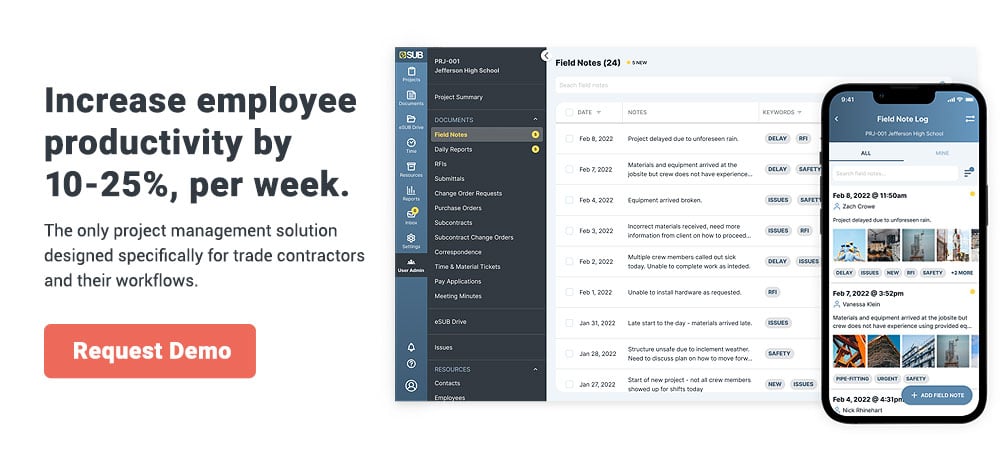5 Best Ways to Manage Correspondence Process Systems
The proper management of incoming and outgoing communication streams is vital to not just construction companies but all businesses in general. Being able to efficiently respond to a client or keep track of instructions from a general contractor empowers a company to reflect professionalism. It also helps avoid pitfalls such as losing critical information that may end in delays and overhead expenses.
While communications were traditionally managed manually, digital solutions have paved the way for automated correspondence processes that minimize errors and time spent. Gone are the days when you had to go through piles of papers to confirm the status of a communication.
Table of Contents
What’s a Correspondence Management System?
Implementing a correspondence management system means monitoring and archiving all business communications made by a construction company. Such a centralized database helps analyze specific project-related information, assemble correspondences between project stakeholders and workers, and deliver timely responses to clients in a secure environment.
For example, a construction company working on multiple projects can receive dozens (or more) calls daily from contractors and owners to inquire about each project. There can also be calls and emails from vendors, engineers, architects, or potential new clients. The mounting incoming and outgoing communications can become extremely difficult to track without a proper correspondence management system. You do not want to lose an important message or send out a reply based on incomplete information. Hence, a good correspondence system helps determine the success of a company.
The following are some correspondence examples every business should be closely managing:
- Blueprints
- Change orders
- Emails
- Letters, faxes, or memorandums
- Meeting agendas
- Project design reviews
- Project manager notes or instructions
- Records of phone conversations
- Requests for information
Best Ways to Manage Your Correspondence Process Systems
There are various benefits to reap from adopting correspondence management solutions for your construction company. Effective communication is only one part of the equation. Streamlining correspondence between clients, owners, vendors, contractors, workers, etc, also helps mitigate risks. Here are some of the best ways to ensure an excellent correspondence system for your company.

1. Go Digital to Manage Communications Better
Keeping an orderly and accurate record of all communications is the most important part of correspondence management. This can be extremely difficult if the record-keeping is being done manually. With the amount of paperwork involved in juggling letters, requests, phone transcripts, instruction orders, and other documentation, using a digital platform to manage correspondence process systems greatly improves the professionalism of your business.
2. Keep Track of Important Contacts for Each Project
Considering how many people with different responsibilities are involved in commercial construction, managing proper correspondence with them is critical for the flow of information. Miscommunication can lead to delays, which results in additional overheads for the project manager. Having an orderly communication platform (or structure) between contractors, architects, engineers, and laborers from the start of the project ensures faster completion and within budget.
3. Don’t Waste Time Generating Correspondence Templates
The correspondence management process of a company always differs from construction project to project. Hence, creating a template as a one-size-fits-all solution is strongly ill-advised. Doing so often wastes time which can set project managers behind schedule. Trying to force a template for every correspondence system also tends to cause major errors.
Project managers should always approve correspondence templates that best fit their company’s processes and policies to ensure everything goes smoothly. Luckily, various digital platforms and construction management software can automatically generate templates based on your requirements. This makes the whole process quicker and achieves improved communication for all parties involved from the start.
4. Keep Your Information Safe and Secure
Securing all data and correspondence between clients should be one of the highest priorities for a construction company. Some communication exchanges may contain sensitive information or private details that should not be made available to the public.
Keeping every message tightly secured, however, can be difficult to manage if they were made on paper copies. It is recommended to use digital platforms for all correspondence process systems. They are safer, more reliable, and feature additional security protocols to safeguard all your data.
5. Store Important Correspondences in One Place
Every correspondence involves keeping records of all communications made. They should always be stored (or backed up) in a single location for easy access. If project managers need to refer to an old communication exchange to confirm change orders, they should not have to jump through hoops to go through various emails, letters, agendas, etc. This is an essential correspondence management tip that protects your business and mitigates downstream risks.
How eSUB Can Help With Correspondence Management
The only way to streamline correspondence management is to adopt a digital solution such as eSUB, a cloud-based construction management software built especially for subcontractors. It can be easily tailored to your company’s needs for effective communications. Featuring a built-in correspondence toolbox and a centralized database, eSUB offers a mobile platform to keep track of projects and communications on the go.


